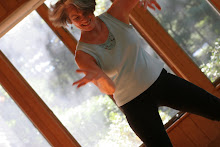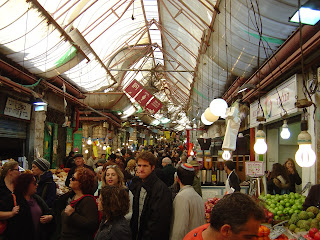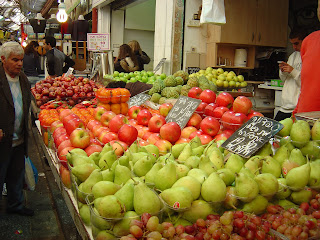Yad Vashem, Har
Herzl, Machanei Yehuda shuk, Shira Hadashah
|
On our third day in Jerusalem, Friday, Dcember 9, 2011, we began our
visit to Yad Vashem with a walk through the children's memorial, inspired and
funded by a Hungarian couple Abe and Edita Spiegel who survived Auschwitz and
reunited after the war. They donated the
memorial in memory of their son Uziel who was murdered at Auschwitz along with
his grandmother. I was struck by how
much the photos of Uziel looked like my husband Alex's baby pictures, and of
course his youngest granddaughter Lena Jane who looks just like him. They
obviously have a similar Eastern European heritage. Inside
the memorial designed by architect Moseh Safdie, it is dark except for five
candles which are reflected by multiple mirrors into a million spots of light
representing the 1.5 million children who were murdered. They died not because of anything they did,
but because of who they were, the accident of their Jewish birth.
The museum
itself had been redesigned during the last couple of years to be a triangular
tunnel through which you can see light at the end. However, you could not pass
straight through. You have to zigzag through all the exhibition rooms to reach
the end. It was an emotionally and physically exhausting experience. I felt
embarrassed about my fatigue. After
all, I was riding in a comfortable coach bus, staying in luxury hotels, and eating
sumptuous meals every day. It was absurd
to compare my strength and stamina to that of the victims who did everything in
their power to keep their families together, and, failing that, everything to
keep their body and soul together, who watched each day as their fellow Jews were systematically murdered.
Ronny did a
masterful job of guiding us through the maze, pointing out many of the most
poignant photographs and videos. One photograph showed a group of women holding
babies, with their hands extended toward the camera, begging for their lives just before being
shot. He told us that 90% of the
photographs were taken by SS officers in an effort to document the
"wonderful" work they were doing for the world by eliminating Jews. A famous Dachau album was found that documented
one transport being processed into the camp. One of the survivors was able to indentify
many of the people in the album as neighbors in her town.
One video was
the testimony of a man who had been a young man in Dachau. He and others were
punished by having to stand outdoors in a thin shirt in sub-freezing weather
between two electrified wires for many hours. He said other boys eventually
fell against the wires in exhaustion and despair, ending their torment. He
worked to distract himself with thoughts of his childhood and, after a while,
with efforts to control his full bladder. When he finally had to release his
urine, he experienced a moment of warmth from the urine running down his legs
before it froze into ice on his legs.
He said that with
all the fantastical images and memories he had used to distract himself, he was
no longer sure if he was alive or dead, dreaming or awake. The SS officer who
eventually released him from this torture was furious that he had survived and
began slapping him over and over across the face. He said that's when he was
sure that he was still alive.
From Yad Vashem,
we went to Har Herzl, the Israeli military cemetery, equivalent of Arlington
cemetery in Washington. Herzl's tomb was marked with HERZL and no other words. Herzl
was a Hungarian Jew who was the father of modern political Zionism and, in
effect, the State of Israel. We saw graves of presidents and generals of
Israel who chose to be buried there. Teddy Kollek is buried there. Others are buried on Mount Zion or with their
families.
When we moved
closer to the graves for young soldiers recently killed, we saw more
elaborations and decorations on the graves. At one grave, two women sat keeping watch. Ronny asked them if it was their relative's
memorial day. They answered that they,
the mother and the aunt, come “Kol yom hashishi,” every Friday, for five years.
At lunchtime, we
went to the shuk near Ben Yehuda Street. It was so crowded, Leslie and I walked
around without buying anything and came back to the room, had some snacks and
got ready for Shabbat.
This minyan functions
as an orthodox congregation, with all the accompanying restrictions. At the same time, they include men and women in the
worship experience as much as possible. The
mehitza was a translucent curtain down the center of the room. Rabbi Weiner sat on the men's side, Myra and I on the women's. The lectern was located in the center of the
room, divided by the curtain which was cut to fit over it. The leadership of the Kabbalat Shabbat
service on Friday night is always assigned to a woman, the following maariv
service to a man. When the woman was
leading, she stood at the lectern, a few inches from the curtain that divided the
room. When the man was leading, he stood
at the same lectern where the woman had previously stood, on the other side of the
curtain. During the dvar torah, the speaker stood at the front of the room and the curtain was pulled all the way back, so that the congregation was one unit. I found this creative use of rules very interesting. My previous experience with orthodox congregations is that women's voices are not heard. This was clearly quite different.
Women and men
both sang in full voice in impressively harmonic arrangements, obviously the
result of much artistic attention and practice.
Rabbi Weiner is acquainted with some of the leaders of the group, who
are willing to share what they have developed with us, possibly with an on-site
consultation in Pittsfield.




0 Comments:
Post a Comment
Subscribe to Post Comments [Atom]
<< Home